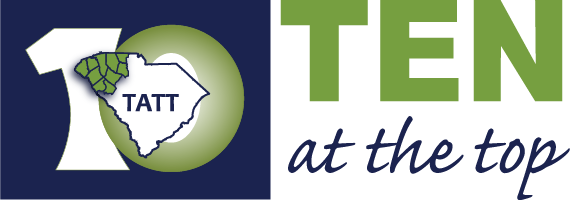with Sharon Purvis

Steve Hoffman, President, Skyline Exhibits and Design
Skyline Exhibits and Design is a one-stop shop for trade show exhibit materials, from signage to custom booth design. Like many industries that revolve around a lot of people being in the same place at once, the trade show industry will need to adapt to a post-COVID world, with social distancing, masks, hybrid virtual/in-person meetings, and increased sanitation, among other considerations. Steve Hoffman is the president of Skyline Exhibits and Design in Greenville, and he answered some questions about the future of trade shows.
Q: There are a lot of changes for trade shows being talked about to respond to the pandemic—but are any of them things that might be permanent changes? And could that be a good thing?
If I focus on “changes” as the crux of your question, we need to remember any change can and will impact decisions and actions by any of these four key trade show players: the owner of the show, the producers of the show, the exhibitors, and the attendees. One item that necessarily is a part of everyone’s calculus both now and on a permanent basis is the financial impact of any change. So if something is done on the early side of shows returning that helps one or more of these groups financially without overly hurting one or more of the other groups, that will likely have the greatest impact on permanence.
A few things that are being considered industry-wide include:
- More space: Owners may seek more space for the totality of their event from a venue, which in turn could widen aisles (easier personal distancing) and enable them to provide larger booth spaces so exhibitors can spread out both their staff and the attendees visiting them on the show floor. Initially, while shows are just starting to come back from postponements and cancellations, it may be an easy incentive for the venues and show owners to offer their exhibitors. But, once there is demand from multiple events for the same venue at the same time, that ability to allow one event to spread out has cost implications.
- Flexible scheduling: This could be offered by event management. They could limit exhibitors to alternating shifts in the hall throughout the day or they could limit attendees to certain show hall times. Either approach could cut down on the “mass gathering” effect; however, neither makes it easier for buyers and sellers to connect on the show floor! To the extent stretched hours impact labor costs, those increases likely get passed on to exhibitors.
- Additional health and safety measures: Most shows (and possibly exhibitors) will be careful to offer things like hand sanitation stations; plexiglass dividers; floor spacing decals; lots of signage pertaining to fevers, coughs, and prior exposure; and even in some cases have temperature screening upon entrance to the expo. However, all will also be careful in not owning liability should someone get sick or exposed. The show’s producers, owners and exhibitors will have incurred additional cost for the precautions.
Q: What kinds of virtual enhancements to trade shows might be implemented?
This year’s rush to anything and everything “virtual” is a reaction to the challenge of how a company can introduce products, services and/or ideas in lieu of the usual face-to-face marketing opportunity inherent in a trade show. However, while some aspects of virtual supplements to the live experience may carry over, once the government regulators, individual venues, travel industry, corporate policies, and personal preferences allow for a return to personal interaction, the live experience will return to pre-eminence. There are some virtual initiatives that are growing in usage now that may remain. These include a “Virtual Booth Experience” where a company creates an interactive 3D rendering of their exhibit booth and touchpoints allow for videos, jpegs, pdfs and information capture much as would happen at a live event. Another example is likely to be greater usage of videoconferencing for follow-up meetings. During the current trade show pause, some exhibitors are using customized virtual platforms. Companies still have a need to communicate and many have budget dollars that had been allocated to shows which are now not being spent. A virtual meeting can enable interactive discussions; it can be live or a pre-taped presentation; and it can be a repository for information and updated information on products. It’s the combination of “live via virtual” plus “info on demand” that makes this option a cut above a regular website or landing page. That same combo may prove beneficial for some marketers when coupled with a return to live trade show exhibiting.
Q: How are trade shows different from other mass gatherings, and how will those differences impact trade shows?
Trade shows have always taken place in a controlled environment that exists for the mutual benefit of an exhibitor and an event attendee. Conversely, a majority of other mass gatherings are aimed either at consumers or are created as a result of spontaneous and/or unplanned proximity of people to one another. The owner of a trade show has the opportunity to employ multiple methods for greater control and social distancing. The impact for exhibitors will likely be more prescheduled appointments with a higher level of decision maker. Attendees will enjoy fewer crowds in aisleways and will want to make best use of their time on the exhibit floor due to possible “traffic flow” directives and staggered attendance hours inside the hall.
Q: In terms of your business, what kinds of things can you do with displays to help with the required changes?—for example, booth size, adding sanitizing stations, floor markers, etc.?
Of course any individual exhibit design would have to account for that organization’s needs, but I think responsible exhibit houses will be taking a greater look at what the exhibitor wants the attendees’ experience to be. Anything interactive will require cleaning between individual touches. Meetings, whether private or semi-private, will likely eat up more space; there will likely be fewer tangible items (literature, samples, giveaways) that are provided at the show, which could mean less in-booth storage is needed. Graphic-based QR codes may be an instant replacement for paper literature. Within a booth space, we’ll likely see greater definition of booth staffer areas and partitions at many conference tables. We may see theatre style presenters behind plexi dividers and fewer seats.
As a positive, I think many exhibitors will really focus on their messaging to be sure the critical ideas cut through clutter and are memorable.
Q: Nearly every surface can be used as advertising space—what are your thoughts on masks as branding opportunities?
Most likely, shows that return will offer this as a sponsorship opportunity. Individual companies will likely offer masks as a giveaway. I’d suggest humor if a company is going to sponsor the official masks at a show because COVID-19 has been so universally negative and disruptive I’m not sure I’d want my brand on every attendee’s face linking me to the pandemic.
Q: Plexiglass—is this something you currently use in your displays, or something you’re having to incorporate now?
I would anticipate “plexi” having a greater prominence at live events. We have used it in exhibit designs forever—sometimes as a window; sometimes as a substrate for a graphic standoff; sometimes as part of custom “look but don’t touch” product demonstrations. We’ve used it in walls and for safety railings and I expect all those applications to continue. However, we will see it used inside of exhibits to create personal barriers at booth staffer stations and small meeting areas. Also, much like in retail, we will see it in the show management’s work areas where exhibitors are placing last-minute orders, picking up items preordered, arranging freight, picking up badges, etc.
One unfortunate but likely scenario is supply and demand will push materials costs up. Not only will plexi be used more often within the industry, but with it being used in so many additional retail or public gathering environments, the basic pricing likely will rise. If we see gas prices climb back up, that will be a double whammy as the plastic materials used in plexi likely have some type of oil by-product in them.
Q: What other kinds of creative things are you seeing/doing to incorporate safety and sanitation into trade show displays?
We’ve been developing some ultraviolet light-enabled cleaners so a visitor to a booth can disinfect their cell phone while having a chat with the booth staffer. Certain flooring products we offer are more friendly towards not retaining viral germs. We have lots of different types of sanitation stations that can attach to exhibit walls or tables or be free-standing.
On the marketing side, we’re talking with some clients about virtual applications either in lieu of or in addition to their traditional exhibit plans.
